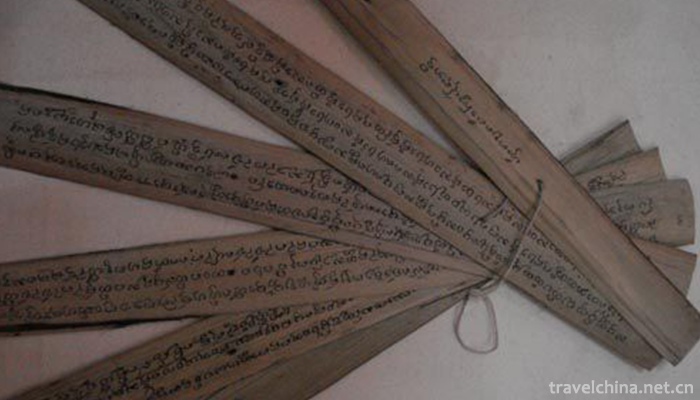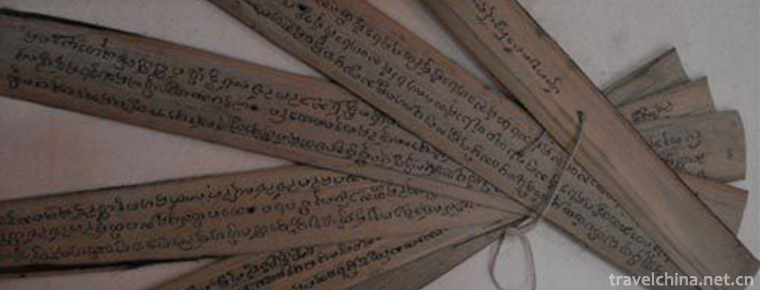Bay Leaf Jing Making Skills
Bay Leaf Jing Making Skills
In June 2008, the technique of making bay leaf Scriptures was listed in the national intangible cultural heritage protection list. The Beiye Sutra (Dai for "lazy") refers to the Buddhist Sutra written on the treated tropical plant Beiye Brown (Dai for "lazy Guo"). After being treated by many traditional and special processes, the bay leaf can prevent insects, waterproof and deformation. The scriptures copied by the bay leaf can be handed down for thousands of years.
On June 7, 2008, Bay Leaf was listed in the second batch of national intangible cultural heritage list with the approval of the State Council.
Historical origin
The Bayesian Classic originated in India and was introduced into the Dai inhabited areas of Yunnan around the 7th century. It has been enriched and developed. Beiye Sutra of Dai nationality not only records Buddhist classics, but also includes many contents of Dai nationality, such as astronomy, calendar, social history, philosophy, law, medicine, science and technology. It is an encyclopedia of Dai culture. It plays an important role in the production and life of Dai people and is regarded as a precious wealth. In Dai Buddhist temples, there is a special Tibetan Sutra Pavilion for the preservation of palm-leaf scriptures. According to folklore, there are more than 80,000 palm-leaf scriptures in ancient times, more than 3,000 in Xishuangbanna, and a large number of them are scattered among the people.
The Dai language is called "Tanlan", which is a classic of Buddhism from the Upper Seat in the south. It is written on a special "Golan" (palm palm leaves) with a folk-made iron pen. The Bayesian Sutra originated in India. It is generally believed that the Baye Sutra was introduced into Sri Lanka around the 7th century AD and then into the southwestern frontier of Yunnan Province through Myanmar and Thailand.
There are about 45,000 Dai palm-leaf scriptures found in Xishuangbanna, Pu'er, Lincang and Dehong of Yunnan, of which more than 2,000 are registered. As the Dai people in Xishuangbanna share the same ethnic origin (Baiyue ethnic group) with the Thai, Lao and Shan people in Thailand and Myanmar, and share the same belief in the Southern Upper Buddhism, their living areas are linked by mountains and rivers, thus forming a Bayesian cultural circle in Southeast Asia. The intangible cultural heritage is often called the "living fossil" of folk cultural history. The Baye Sutra of Yunnan is one of the "living fossils", which is called "Dai culture carved on leaves", which is unique to China and one of the most precious cultural treasures of the Chinese nation.
Inheritance significance
The Dai Beiye Sutra refers to the Scriptures recorded on the bayette with Buddhist classics as the core content. It has played an important role in the social and economic development of the Dai people, the dissemination of Buddhist ideas and the inheritance of Buddhist culture.
Among the numerous national intangible cultural heritages, the Baye Sutra is unique because of its unique craftsmanship and Dai culture. It is only used in Dehong, Xishuangbanna and other places in Yunnan, China. The famous "Shaoshutun" (Peacock Princess Story) comes from the Southern Dai Buddhist classic "Baye Sutra" in Yunnan. It is self-evident that the protection of the palm-leaf scriptures is of great significance. However, the reality is that there are many people in Yunnan who can speak Dai language, but few people can understand and write Dai language, and even fewer can write the Baye Sutra. Fortunately, the protection of "living fossils" in Yunnan has been ongoing.


-
2.Crab Dumplings in Soup
Crab yellow soup bag is a traditional snack in Jiangsu Province. The crab yellow soup bag is made of crab yellow and crab meat with stuffing
Time 2018-10-27 -
3.Global Dinosaur City Scenic Spot
The National 5A Tourist Scenic Spot Global Dinosaur City, located in Xinbei District, Changzhou, Jiangsu Province, is a comprehensive tourism resort with dinosaur theme
Time 2018-12-06 -
4.Shaoshan
Shaoshan City, which belongs to Hunan Province, is located in the hilly area of central Hunan Province east of central Hunan Province. Shaoshan is situated in the west of Xiangtan City
Time 2018-12-12 -
5.Donghekou Earthquake Relics Park
Donghekou Earthquake Site Park is the first earthquake site protection memorial site of Wenchuan Earthquake, located in Qingchuan County, Guangyuan City, Sichuan Province
Time 2018-12-20 -
6.Korean Dongxiao Music
The Koguryo History Music Records records that Dongxiao belonged to the musical instruments of the Tang Dynasty in China. During the period of Shizong in the Li Dynasty
Time 2019-04-16 -
7.Chengdu lacquer art
Chengdu lacquer art, the traditional handicraft of Chengdu City, Sichuan Province, is one of the national intangible cultural heritage.
Time 2019-04-18 -
8.Traditional Brewing Techniques of Brewing Wine
The traditional brewing technology of Jinhua liquor is the traditional handicraft technology of Jinhua City, Zhejiang Province. The typical representative and complete remains
Time 2019-06-07 -
9.Sharipol wrestling
Shaliboer style wrestling is a national traditional sports event originally created and retained by the Weilat Mongolian people. It is one of the main sports events in the Uznada Mu Grand Event in Ala
Time 2019-06-12 -
10.Inkstone making skills
Inkstone making skills, local traditional handmade inkstone making skills in Shexian County of Anhui Province and Wuyuan County of Jiangxi Province, is one of the national intangible cultural heritage
Time 2019-07-01 -
11.Weaving and Dyeing Techniques of Adlais Silk
Adlais silk is produced in Jiya Township, Luopu County, located in the northwest of Luopu County, on the East Bank of the middle and lower reaches of the Yulong Kashi River. Ancient Hetian was the tra
Time 2019-07-06 -
12.Population and nationality of Suining
At the end of 2019, the total number of household registration in Suining was 1 million 380 thousand, and the household registration population was 3 million 629 thousand, a decrease of 0.7% over the previous year, of which 1 million 4 thousand and 900
Time 2020-12-16